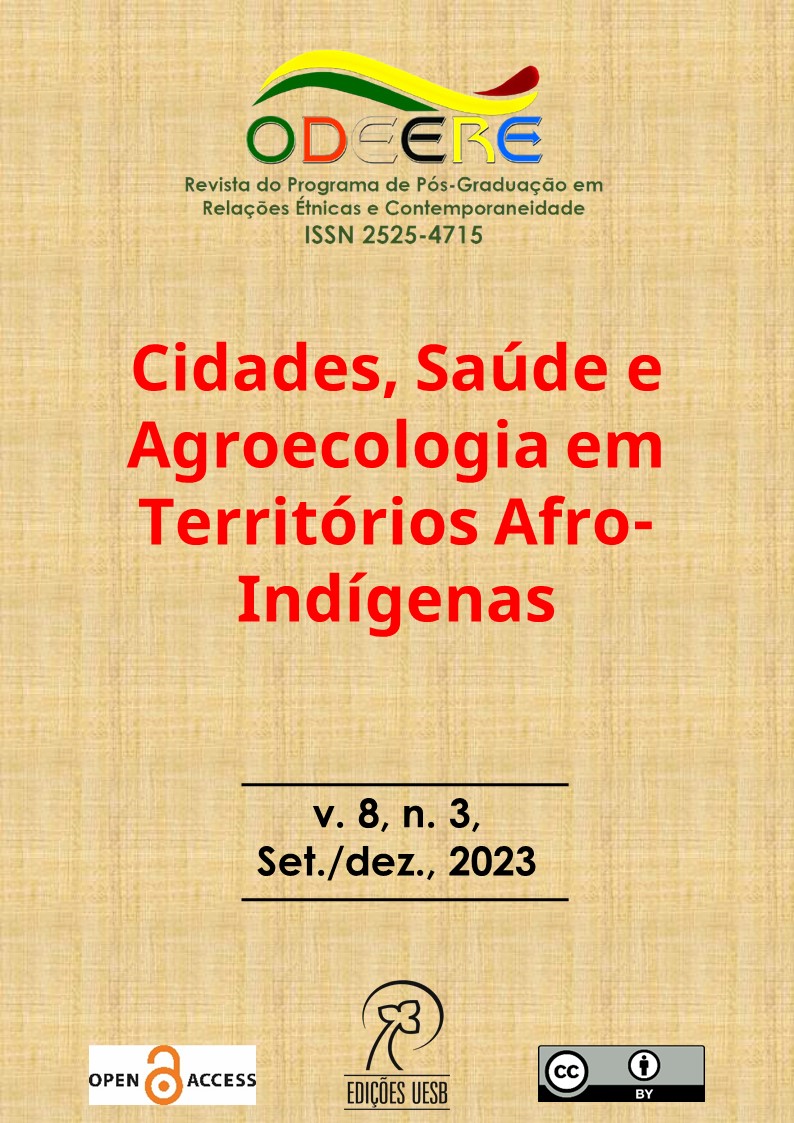Saberes ancestrais como promoção à saúde física e mental: um olhar agroecológico
DOI:
https://doi.org/10.22481/odeere.v8i3.13872Palavras-chave:
Ancestralidade , Intoxicações alimentares, Produção agroecológicaResumo
A agricultura industrial usa muitos xenobióticos que afetam o microbioma humano, desencadeia disbiose e compromete o desenvolvimento neurológico e neuropsiquiátrico. Em contrapartida, hábitos alimentares ancestrais indicam que a diversificação alimentar, incluindo vegetais e proteínas, isentos de agroquímicos, promovem a saúde mental e física além que viabilizar o equilíbrio no meio ambiente. Como solução deve-se unir o saber ancestral com a Agroecologia para resgatar a saúde humana.
Downloads
Referências
ACKERMANN, W.; COENEN, M.; SCHRÖDL, W.; SHEHATA, A. A.; KRÜGER, M. The Influence of Glyphosate on the Microbiota and Production of Botulinum Neurotoxin During Ruminal Fermentation. Current Microbiology, v. 70, p.374-382, 2015. DOI: https://doi.org/10.1007/s00284-014-0732-3
AGRICULTURA. In: DICIO, Dicionário Online de Português. 2023. Disponível em: https://www.dicio.com.br/agricultura/
ALLEN, A. P.; DINAN, T. G.; CLARKE, G.; CRYAN, J. F. A psychology of the human brain-gut-microbiome axis. Soc Personal Psychol Compass. v.11, p.e12309, 2017. DOI: https://doi.org/10.1111/spc3.12309.
BÄCKHED, F.; LEY, R. E.; SONNENBURG, J. L.; PETERSON, D. A.; GORDON, J. I. Host-Bacterial Mutualism in the Human Intestine. Science, v. 307, p. 1915-1920, 2005.
BEN-DOR, M.; BARKAI, R. The importance of large prey animals during the Pleistocene and the implications of their extinction on the use of dietary ethnographic analogies. Journal of Anthropological Archaeology, v. 59, p.101192, 2020.
BENAKIS, C.; MARTIN-GALLAUSIAUX, C.; TREZZI, J.-P.; MELTON, P.; LIESZ, A.; WILMES, P. The microbiome-gut-brain axis in acute and chronic brain diseases. Current Opinion in Neurobiology, v. 61, p.1–9, 2020.
BIANCO, A. L. Modernidade e Degeneração: A Crítica de Weston Price. Socitec E-Prints, v. 3, n. 1, p. 34-52, 2009.
BONILLA-ALDANA, D. K. DHAMA, K.; RODRIGUEZ-MORALES, A. J. Revisiting the One Health Approach in the Context of COVID-19: A Look into the Ecology of this Emerging Disease. Advances in Animal and Veterinary Sciences, v. 8, n. 3, p. 234-237, 2020. DOI: http://dx.doi.org/10.17582/journal.aavs/2020/8.3.234.237
BYRNES, S. The Neglected Nutritional Research of Dr. Weston Price, DDS. Mercola, p. 1-8, 2001. http://articles.mercola.com/sites/articles/archive/2001/01/21/weston-price.aspx
CARDENAS, D. Let not thy food be confused with thy medicine: the Hippocratic misquotation. e-SPEN Journal, v.8, p. e260–e262, 2013.
CARSON, R. Silent Spring. 1. ed. 1962. Boston: Mariner Books, 2002.
CHLOPECKA, M. MENDEL, M.; DZIEKAN, N.; KARLIK, W. Glyphosate affects the spontaneous motoric activity of intestine at very low doses—in vitro study. Pestic Biochem Physiol, v.113, p.25–30, 2014.
CRITTENDEN, A. N.; SORRENTINO, J.; MOONIE, S. A.; PETERSON, M.; MABULLA, A.; UNGAR, P. S. Oral health in transition: The Hadza foragers of Tanzania. PLoS ONE, v. 12, n.3, p. e0172197, 2017. DOI: https://doi.org/10.1371/journal.pone.0172197
CRUMEYROLLE-ARIAS, M.; JAGLIN, M.; BRUNEAU, A.; VANCASSEL, S.; CARDONA, A.; DAUGÉ, V.; NAUDON, L.; RABOT, S. Absence of the gut microbiota enhances anxiety-like behavior and neuroendocrine response to acute stress in rats. Psychoneuroendocrinology, v. 42, p. 207-217, 2014. DOI: http://dx.doi.org/10.1016/j.psyneuen.2014.01.014
DESBONNET, L.; CLARKE, G.; SHANAHAN, F.; DINAN, T. G.; CRYAN, J. F. Microbiota is essential for social development in the mouse. Molecular Psychiatry, v.19, p. 146-148, 2014. DOI: https://doi.org/10.1038/mp.2013.65
EVRENSEL, A.; CEYLAN, M. E. The Gut-Brain Axis: The Missing Link in Depression. Clinical Psychopharmacology and Neuroscience, v. 13, p.3, p. 239-244, 2015. DOI: http://dx.doi.org/10.9758/cpn.2015.13.3.239
FOOD. In: Encyclopædia Britannica. 2021. Disponível em: <https://www.britannica.com/search?query=food>. Acesso em: 06/09/2023.
FORBES, J. D.; DOMSELAAR, G. V.; BERNSTEIN, C. N. The Gut Microbiota in Immune-Mediated Inflammatory Diseases. Frontiers in Microbiology, v. 7, n. 1081, p. 1-18, 2016. DOI: https://doi.org/10.3389/fmicb.2016.01081
FOSTER, J. A.; NEUFELD, K. A. M. Gut–brain axis: how the microbiome influences anxiety and depression. Trends in Neurosciences, v. 36, n. 5, 2013. DOI: http://dx.doi.org/10.1016/j.tins.2013.01.005
FOWLIE, G.; COHEN, N.; MING, X. The Perturbance of Microbiome and Gut-Brain Axis in Autism Spectrum Disorders. International Journal of Molecular Sciences, v. 19, n. 2251, p. 1-4, 2018. DOI: https://doi.org/10.3390/ijms19082251
GILL, S. R.; POP, M.; DEBOY, R. T.; ECKBURG, P. B.; TURNBAUGH, P. J.; SAMUEL, B. S.; GORDON, J. I.; RELMAN, D. A.; FRASER-LIGGETT, C. M.; NELSON, K. E. Metagenomic Analysis of the Human Distal Gut Microbiome. Science, v. 312, p. 1355-1359, 2006.
GOTO, Y.; KURASHIMA, Y.; KIYONO, H. The gut microbiota and inflammatory bowel disease. Current Opinion in Rheumatology, v. 27, n.4, p. 388-396, 2015. DOI: https://doi.org/10.1097/BOR.0000000000000192
GRENHAM, S.; CLARKE, G.; CRYAN, J. F.; DINAN, T. G. Brain–gut–microbe communication in health and disease. Frontiers in Physiology, v. 2, n. 94, p. 1-15, 2011. DOI: https://doi.org/10.3389/fphys.2011.00094
GROVA, N.; SCHROEDER, H.; OLIVIER, J.-L.; TURNER, J. D. Epigenetic and Neurological Impairments Associated with Early Life Exposure to Persistent Organic Pollutants. International Journal of Genomics, ID 2085496, 2019. DOI: https://doi.org/10.1155/2019/2085496
GUSTAFSON. C. Joan Grinzi, RN, and David Getoff, CCN: Preserving and Advancing the Nutrition Research of Weston A. Prince, DDS, and Francis M. Pottenger, Jr, MD. Integrative Medicine, v. 13, n. 1, 2014.
HILL, J. M.; CLEMENT, C.; POGUE, A. I.; BHATTACHARJEE, S.; ZHAO, Y.; LUKIW, W. J. Pathogenic microbes, the microbiome, and Alzheimer’s disease (AD). Frontiers in Aging Neuroscience, v. 6, n. 127, 2014. DOI: https://doi.org/10.3389/fnagi.2014.00127
KELLY, J. R.; BORRE, Y.; O' BRIEN, C.; PATTERSON, E.; EL AIDY, S.; DEANE, J.; KENNEDY, P. J.; BEERS, S., SCOTT, K.; MOLONEY, G.; HOBAN, A. E.; SCOTT, L.; FITZGERALD, P.; ROSS, P.; STANTON, C.; CLARKE, G.; CRYAN, J. F.; DINAN, T. G. Transferring the blues: Depression-associated gut microbiota induces neurobehavioural changes in the rat. Journal of Psychiatric Research, v. 82, p. 109-118, 2016. DOI: http://dx.doi.org/10.1016/j.jpsychires.2016.07.019
KHAN, I.; ULLAH, N.; ZHA, L.; BAI, Y.; KHAN, A.; ZHAO, T.; CHE, T.; ZHANG, C. Alteration of Gut Microbiota in Inflammatory Bowel Disease (IBD): Cause or Consequence? IBD Treatment Targeting the Gut Microbiome. Pathogens, v. 8, n. 126, p. 1-28, 2019. DOI: https://doi.org/10.3390/pathogens8030126
KITTLE, R. P.; MCDERMID, K. J.; MUEHLSTEIN, L.; BALAZS, G. H. Effects of glyphosate herbicide on the gastrointestinal microflora of Hawaiian green turtles (Chelonia mydas) Linnaeus. Marine Pollution Bulletin, v. 127, p. 170-174, 2018. DOI: https://doi.org/10.1016/j.marpolbul.2017.11.030
LEAKEY, L. S. B.; TOBIAS, P. V.; NAPIER, J. R. A. New Species of The Genus Homo From Olduvai Gorge. Nature, v. 202, n. 4927, p.7-9, 1964. ISSN 0028-0836. DOI: https://doi.org/10.1038/202007a0
LEAL, M. L.; ALVES, R. P.; HANAZAKI, N. Knowledge, use, and disuse of unconventional food plants. Journal of Ethnobiology and Ethnomedicine, v. 14, n. 6, p. 1-9, 2018. DOI: https://doi.org/10.1186/s13002-018-0209-8
LEY, R. E.; PETERSON, D. A.; GORDON, J. I. Shaping Microbial Diversity in the Human Intestine. Cell, v. 124, p. 837-848, 2006.
LIANG, S.; WU, X.; HU, X.; WANG, T.; JIN, F. Recognizing Depression from the Microbiota–Gut–Brain Axis. International Journal of Molecular Sciences, v. 19, n. 1592, p. 1-16, 2018. DOI: https://doi.org/10.3390/ijms19061592
LLOYD-PRICE, J.; ABU-ALI, G.; HUTTENHOWER, C. The healthy human microbiome. Genome Medicine, v. 8, n.51, p. 1-11, 2016. DOI: https://doi.org/10.1186/s13073-016-0307-y
MARTÍNEZ, I.; STEGEN, J. C.; MALDONADO-GÓMEZ, M. X.; EREN, A. M.; SIBA, P. M.; GREENHILL, A. R.; WALTER, J. The Gut Microbiota of Rural Papua New Guineans: Composition, Diversity Patterns, and Ecological Processes. Cell Reports, v. 11, p. 527-538, 2015.
MOURA, H. F. S.; DIAS, F. S.; SOUZA, L. B. S.; MAGALHÃES, B. E. A.; TANNUS, C. A.; CARVALHO, W. C.; BRANDÃO, G. C.; SANTOS, W. N. L.; KORN, M. G. A.; SANTOS, D. C. M. B.; LOPES, M. V.; SANTANA, D. A.; SANTOS JÚNIOR, A. F. Evaluation of multielement/proximate composition and bioactive phenolics contents of unconventional edible plants from Brazil using multivariate analysis techniques. Food Chemistry, v. 363, p. 129995, 2021. DOI: https://doi.org/10.1016/j.foodchem.2021.129995
OLIVEIRA, R. M. S. Quilombos, racismo ambiental e formação em saúde e saúde mental: diálogos emergentes. ODEERE, v.5, n. 10, p. 129-156, 2020.
PRICE, W. A. Nutrition and Physical Degeneration: A Comparison of Primitive and Modern Diets and Their Effects. New York: Hoeber, 1939. 445 p.
PRIMAVESI, A. O solo tropical – Casos – Perguntando sobre solos. Fundação Mokiti Okada. São Paulo – SP, 1º Ed., 2009. 115p.
SAMSEL, A.; SENEFF, S. Glyphosate’s Suppression of Cytochrome P450 Enzymes and Amino Acid Biosynthesis by the Gut Microbiome: Pathways to Modern Diseases. Entropy, v. 15, p. 1416-1463, 2013. DOI: https://doi.org/10.3390/e15041416
SCHNORR, S. L.; CANDELA, M.; RAMPELLI, S.; CENTANNI, M.; CONSOLANDI, C.; BASAGLIA, G.; TURRONI, S.; BIAGI, E.; PEANO, C.; SEVERGNINI, M.; FIORI, J.; GOTTI, R.; BELLIS, G.; LUISELLI, D.; BRIGIDI, P.; MABULLA, A.; MARLOWE, F.; HENRY, A. G.; CRITTENDEN, A. N. Gut microbiome of the Hadza hunter-gatherers. Nature Communications, v. 5, p. 3654, 2014. DOI: https://doi.org/10.1038/ncomms4654
SÉRALINI, G.-E.; CLAIR, E.; MESNAGE, R.; GRESS, S.; DEFARGE, N.; MALATESTA, M.; HENNEQUIN, D.; VENDÔMOIS, J. S. Republished study: long-term toxicity of a Roundup herbicide and a Roundup-tolerant genetically modified maize. Environmental Sciences Europe. v.26, n.14, 2014.
TANG, W. H. W.; BÄCKHED, F.; LANDMESSER, U.; HAZEN, S. L. Intestinal Microbiota in Cardiovascular Health and Disease JACC State-of-the-Art Review. Journal of the American College of Cardiology, v. 73, n. 16, p. 2089-2105, 2019. DOI: https://doi.org/10.1016/j.jacc.2019.03.024
TANG, W. H. W.; KITAI, T.; HAZEN, S. L. Gut Microbiota in Cardiovascular Health and Disease. Circulation Research, v. 120, n. 7, p. 1183-1196, 2017. DOI: https://doi.org/10.1161/CIRCRESAHA.117.309715
TURRONI, S.; FIORI, J.; RAMPELLI, S.; SCHNORR, S. L.; CONSOLANDI, C.; BARONE, M.; BIAGI, E.; FANELLI, F.; MEZZULLO, M.; CRITTENDEN, A. N.; HENRY, A. G.; BRIGIDI, P.; CANDELA, M. Fecal metabolome of the Hadza hunter-gatherers: a host-microbiome integrative view. Scientific Reports, v. 6, n. 32826, p. 1-9, 2016. DOI: https://doi.org/10.1038/srep32826
VALLES-COLOMER, M.; FALONY, G.; DARZI, Y.; TIGCHELAAR, E. F.; WANG, J.; TITO, R. Y.; SCHIWECK, C.; KURILSHIKOV, A.; JOOSSENS, M.; WIJMENGA, C.; CLAES, S.; OUDENHOVE, L. V.; ZHERNAKOVA, A.; VIEIRA-SILVA, S.; RAES, J. The neuroactive potential of the human gut microbiota in quality of life and depression. Nature Microbiology, 2019. DOI: https://doi.org/10.1038/s41564-018-0337-x
VIJAY, A.; VALDES, A. M. Role of the gut microbiome in chronic diseases: a narrative review. European Journal of Clinical Nutrition. v. 76. p. 489–501, 2022. DOI: https://doi.org/10.1038/s41430-021-00991-6
WHO. Health and Well-Being. [Internet]. 2023. Disponível em: https://www.who.int/data/gho/data/major-themes/health-and-well-being
ZHU, X.; LI, B.; LOU, P.; DAI, T.; CHEN, Y.; ZHUGE, A.; YUAN, Y.; LI, L. The Relationship Between the Gut Microbiome and Neurodegenerative Diseases. Neuroscience Bulletin, v. 37, n.10, p.1510–1522, 2021. DOI: https://doi.org/10.1007/s12264-021-00730-8
ZYSSET-BURRI, D. C.; MORANDI, S.; HERZOG, E. L.; BERGER, L. E.; ZINKERNAGEL, M. S. The role of the gut microbiome in eye diseases. Progress in Retinal and Eye Research, v. 92, p.101117, 2023.
Downloads
Publicado
Como Citar
Edição
Seção
Licença
Copyright (c) 2023 ODEERE

Este trabalho está licenciado sob uma licença Creative Commons Attribution 4.0 International License.
Você é livre para:
Compartilhar - copia e redistribui o material em qualquer meio ou formato; Adapte - remixe, transforme e construa a partir do material para qualquer propósito, mesmo comercialmente. Esta licença é aceitável para Obras Culturais Livres. O licenciante não pode revogar essas liberdades, desde que você siga os termos da licença.
Sob os seguintes termos:
Atribuição - você deve dar o crédito apropriado, fornecer um link para a licença e indicar se alguma alteração foi feita. Você pode fazer isso de qualquer maneira razoável, mas não de uma forma que sugira que você ou seu uso seja aprovado pelo licenciante.
Não há restrições adicionais - Você não pode aplicar termos legais ou medidas tecnológicas que restrinjam legalmente outros para fazer qualquer uso permitido pela licença.











